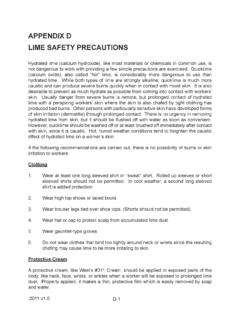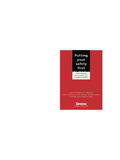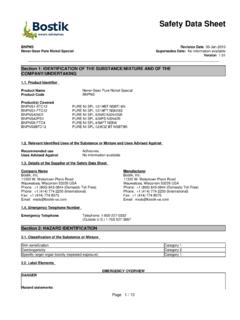Transcription of Safety and health in the use of machinery
1 ISBN978-92-2-127725-59789221277255 Code of practice ILO Safety and health in the use of machinery Safety and health in the use of machinery Safety and health in the use of machineryMachinery is used in virtually all work activities, and thus presents certain Safety and health risks in a large number of workplaces all over the world. Many new types of machinery are also introduced into the market each year. This code of practice sets out principles concerning Safety and health in the use of machinery and defines Safety and health technical requirements and precautions , including those relating to the working environment, control systems, machinery guarding and protection against hazards, information and marking, and supplementary measures relating to specific machinery types. The code applies to any work activity in which machinery is used and to all stages of the life cycle of machinery , including second-hand, rebuilt or redeployed machinery used in and health in the use of machineryILO code of practiceSafety and health in the use of machineryInternational Labour Office GenevaCopyright International Labour Organization 2013 First published 2013 Publications of the International Labour Office enjoy copyright under Protocol 2 of the Universal Copy-right Convention.
2 Nevertheless, short excerpts from them may be reproduced without authorization, on condition that the source is indicated. For rights of reproduction or translation, application should be made to ILO Publications (Rights and Permissions), International Labour Office, CH-1211 Geneva 22, Switzerland, or by email: The International Labour Office welcomes such , institutions and other users registered with reproduction rights organizations may make copies in accordance with the licences issued to them for this purpose. Visit to find the reproduc-tion rights organization in your Safety end health in the use of machinery . ILO code of practiceGeneva, International Labour Office, Programme on Safety and health at Work and the Environment, 2013 ISBN 978-92-2-127725-5 (print)ISBN 978-92-2-127726-2 (web pdf )occupational Safety / occupational health / hazard / protective equipment / machinery / code of practice available in French: La s curit et la sant dans l utilisation des machines (ISBN 978-92-2-227725-4), Geneva, 2013, and in Spanish: Seguridad y salud en la utilizaci n de la maquinaria (ISBN 978-92-2-327725-3), Geneva, 2013.
3 ILO Cataloguing in Publication DataThe designations employed in ILO publications, which are in conformity with United Nations practice, and the presentation of material therein do not imply the expression of any opinion whatsoever on the part of the International Labour Office concerning the legal status of any country, area or territory or of its authorities, or concerning the delimitation of its responsibility for opinions expressed in signed articles, studies and other contributions rests solely with their authors, and publication does not constitute an endorsement by the International Labour Office of the opinions expressed in them. Reference to names of firms and commercial products and processes does not imply their endorsement by the International Labour Office, and any failure to mention a particular firm, commercial product or process is not a sign of publications and electronic products can be obtained through major booksellers or ILO local offices in many countries, or direct from ILO Publications, International Labour Office, CH-1211 Geneva 22, Switzerland.
4 Catalogues or lists of new publications are available free of charge from the above address, or by email: our website: publication was produced by the Document and Publications Production, Printing and Distribution Branch (PRODOC) of the ILO. Graphic and typographic design, layout and composition, manuscript preparation, copy editing, proofreading, printing, electronic publishing and endeavours to use paper sourced from forests managed in an environmentally sustainable and socially responsible : DTP-CAD-CORR-NOU-IMPRVP refaceThis new ILO code of practice sets out principles concerning Safety and health in the use of machinery and defines Safety and health requirements and precautions applicable to governments, workers and employers, and also to designers, manufacturers and suppliers of machinery . machinery is used in virtually all work activities, and thus presents certain Safety and health risks in a large number of workplaces all over the world.
5 Many new types of machinery are also introduced each year, hence the urgent need for a systematic approach to ensure Safety and health when machinery is put on the ILO Global Strategy on Occupational Safety and health adopted in 2003 called for the revision of the Guarding of machinery Con-vention, 1963 (No. 119), and Recommendation (No. 118), and recom-mended that Priority should also be given to the development of a new instrument on the guarding of machinery in the form of a code of practice .In response, the Governing Body of the International Labour Office, at its 306th Session (November 2009), took the decision to convene a meeting of experts to draw up a code of practice on Safety and health in the use of machinery . The meeting was held in Geneva from 29 November to 7 December 2011. Eight experts appointed following consultations with governments, eight following consultations with the Employers group and eight following consultations with the Workers group of the Governing Body participated in the meeting.
6 After exam-ining and finalizing the text, based on a draft prepared by the Office, the experts adopted this code of practice. In view of the comprehensive needs of all the stakeholders, this new code covers a much broader scope in addition to the guarding of practical recommendations of this code of practice are intended for the use of all those who have a responsibility for Safety and health VISafety and health in the use of machineryin the use of machinery . The code is not intended to replace national laws, regulations or accepted standards. Its object is to provide guid-ance to those who may be engaged in the framing of provisions relating to the use of machinery at work, such as competent authorities and the management of companies where machinery is supplied or used. The code also offers guidelines to designers, manufacturers, suppliers and employers and workers circumstances and the availability of financial and technical resources will determine the speed and extent of implementation.
7 The provisions of this code should also be read in the context of the condi-tions in the country proposing to use the information. With this in mind, the needs of developing countries have been taken into text of the code was approved for publication by the Governing Body of the ILO at its 313th Session (March 2012).VIIList of participantsChairpersonMs R. Edwards, Regional Director, Midlands, health and Safety Executive (United Kingdom)Experts appointed after consultations with governmentsDr J. Basri, Director-General, Department of Occupational Safety and health (Malaysia)AdviserMr A. Yahya, Director, Department of Occupational Safety and health (Malaysia)Ms A. Becker, Auditora Fiscal do Trabalho, Ministerio do Trabalho e Emprego (Brazil)Mr F. Boye, Acting Chief Inspector of Factories, Department of Factories Inspectorate (Ghana)Mr J. Malatse, Director of Electrical and Mechanical Engineering, Department of Labour (South Africa)Mr G.
8 Mansour, Provincial Coordinator, Specialized Professional Services, Ontario Ministry of Labour (Canada)Mr C. Maujean, Senior Officer, Coordination of Work Equipment Inquiries Standardization and Market Surveillance of machinery (France)Mr T. M ssner, Expert for Safety of machinery and Mechanical Hazards, Federal Institute for Occupational Safety and health (Germany)Mr T. Saito, Senior Researcher, Mechanical Safety Researching Group, National Institute of Occupational Safety and health (Japan)VIIIS afety and health in the use of machineryExperts appointed after consultations with the Employers groupMr J. Gallego P rez, Engineer, Inversiones Mundial SA (Colombia)Mr P. Jarvie, Occupational health and Safety Manager, Employers and Manufacturers Association (New Zealand)Mr N. Kawaike, General Manager for Standardization Division, Japan machinery Federation (Japan)Mr N. Mphofu, health and Safety Manager, Steel and Engineering Industry Federation of South Africa (South Africa)Ms M.
9 Nilsson, Expert and Adviser on Occupational Safety and Work Environment, the Association of Swedish Engineering Industries (Sweden)Dr S. Sandrock, Researcher on Applied Ergonomics, Institut f r angewandte Arbeitswissenschaft (Germany)Mr L. Wong Moi Sang, Employers Adviser, Mauritius Employers Federation (Mauritius)Mr U. Wortmann, EMEA HS&E Manager, Procter & Gamble (Belgium)Experts appointed after consultations with the Workers groupMs J. Bodibe, Policy Coordinator on Occupational health and Safety , Congress of South African Trade Unions (South Africa)Mr M. Breidbach, Member of Global health and Safety Committee, Coordinator EWC WG health and Safety , IGM, Arcelor Mittal Bremen GmbH (Germany)Mr N. Hosokawa, Japanese Electronic and Information Union (Japan)IXList of participantsMs F. Murie, Director of health and Safety , Building and Wood- workers International (Switzerland)Mr L. Carlos de Oliveira, Director of the Sindicato dos Metal rgicos de S o Paulo, and Director of For a Sindical (Brazil)Mr S.
10 Sallman, Safety and health Specialist, United Steelworkers (United States)Mr R. Sneddon, Community National health and Safety Officer, The Grange (United Kingdom)Ms D. Vallance, National OHS Coordinator, Australian Manufactur- ing Workers Union (Australia)International governmental and non-governmental organizations representedWorld health Organization (WHO): Dr Ivan D. Ivanov, Dr Evelyn Kortum; WHO Collaborating Centre for Occupational health : Dr Vladimir MurashovInternational Organisation of Employers (IOE): Dr Janet AshersonInternational Trade Union Confederation (ITUC): Ms Esther BusserILO secretariatMr Seiji Machida, Director Programme on Safety and health at Work and the Environment (SafeWork)Dr Tsuyoshi Kawakami, Coordinator, Occupational Safety , Policy and Management Systems Cluster Programme on Safety and health at Work and the Environment (SafeWork)Dr Shengli Niu, Coordinator and Senior Specialist, Occupational health Cluster Programme on Safety and health at Work and the Environment (SafeWork)XSafety and health in the use of machineryMr Pavan Baichoo, Technical Specialist, Occupational Safety , Policy and Management Systems Cluster Programme on Safety and health at Work and the Environment (SafeWork)Dr Marie-Louise Riley-Roberts, ILO Consultant, health and Safety Executive (United Kingdom)Ms Tuiri Kerttula, ILO Consultant, Finnish Safety and Chemicals Agency (Tukes) (Finland)ContentsXIContentsPreface.















